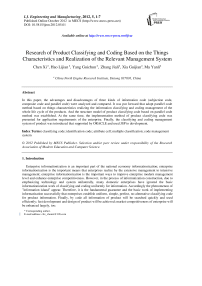Research of Product Classifying and Coding Based on the Things Characteristics and Realization of the Relevant Management System
Автор: Chen Xi, Hao Lijian, Yang Guichun, Zhang Jialia, Xia Guijiana, Ma Yanlia
Журнал: International Journal of Engineering and Manufacturing(IJEM) @ijem
Статья в выпуске: 5 vol.2, 2012 года.
Бесплатный доступ
In this paper, the advantages and disadvantages of three kinds of information code (subjection code, composite code and parallel code) were analyzed and compared. It was put forward that adopt parallel code method based on things characteristics realizing the information classifying and coding management of the whole life cycle of the products. And the structure model of product classifying code based on parallel code method was established. At the same time, the implementation method of product classifying code was presented for application requirements of the enterprise. Finally, the classifying and coding management system of product was introduced that supported by ORACLE and used JSP to development.
Classifying code, identification code, attribute cell, multiple classification, code management system
Короткий адрес: https://sciup.org/15014331
IDR: 15014331
Список литературы Research of Product Classifying and Coding Based on the Things Characteristics and Realization of the Relevant Management System
- T Warren Liao, 2001] T. Warren Liao. Classification and coding approaches to part family formation under a fuzzy environment [J]. Fuzzy Sets and Systems, 2001, 122: 425-441.
- LI Ying-hua. On Problem Classification and Coding for Two-dimensional Geometric Nesting[J]. MECHANICAL SCIENCE AND TECHNOLOGY, 2000.
- Xie Xi-hua, He Qing-hua,Zhou Liang. Classification coding mode of PDM based on flexible structure [J]. Computer Integrated Manufacturing Systems, 2005.
- Joerg, 2002] Joerg Leukel, Volker Schmitz, Frank-Dieter Dorloff. A Modeling Approach for Product Classification Systems[C]. Proceedings of the 13th International Workshop on Database and Expert Systems Applications (DEXA'02), 2002.


